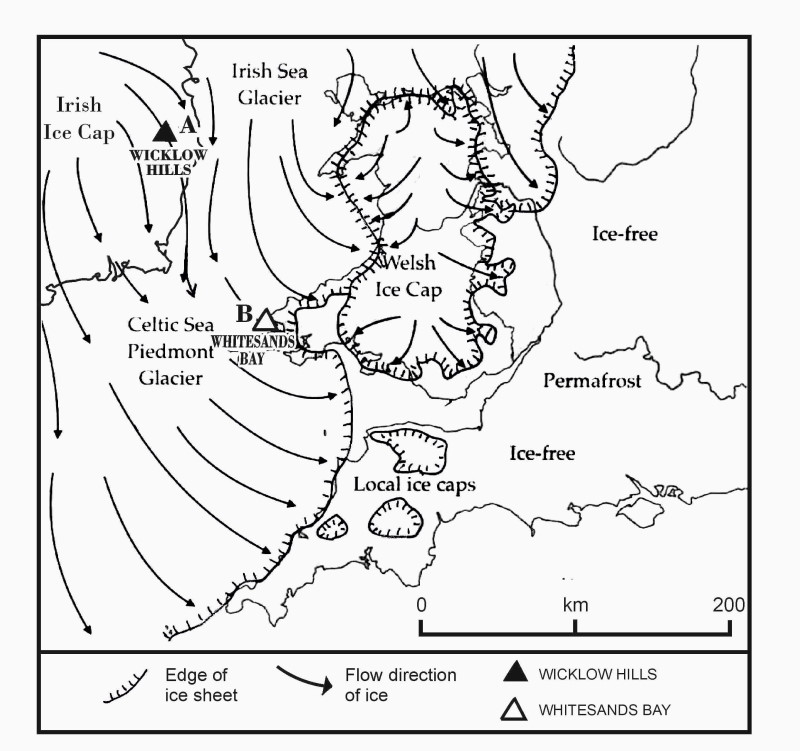A Gold Nugget from a Pembrokeshore Beach
In the 1980’s well-known Pembrokeshire metal detectorist Roy J. Lewis of Haverfordwest found a small gold nugget while detecting on Whitesands Beach after a winter storm. Ron wrote about it in the local paper. He told the story of how it was probably Irish gold and had been brought to Pembrokeshire by someone crossing from Ireland to the small harbour of St. Justinians (near St. Davids) before losing it on Whitesands Bay. Today the nugget is housed in the National Museum of Wales (Item No. 2016.11 H) and a photograph of it can be seen at their website ‘Collections on Line’. But the story has changed somewhat. It is now identified as an Early Bronze Age nugget with a composition similar to Bronze Age lunulae (moon- shaped pendants) originating either in Ireland or Cornwall. Presumably it was carried to the area and lost by somebody near a boat landing place. The location is given as near the base of a cliff at Whitesands Bay.
As a geologist I would suggest a different origin. First the Bronze Age connection is only because the Bronze Age metal work is made using natural gold nuggets. There was no metal refining at the time, so the composition would be natural as found. This means the gold is combined with silver, some copper and other elements. Natural gold composition varies from place to place. The earliest Greek coins were made of electrum – a natural alloy of gold and silver. Today gold chemistry is important to gold police in identifying sources of gold. The museum photograph shows the nugget is well rounded. This is typical of placer gold where the grain has been rolled around by water – either in a river or the sea or both.
Gold is rare in Pembrokeshire, but it does occur in two places. First it can be found in Treffgarne Gorge as placer gold. In the hills nearby the British Geological Survey has drilled through gold bearing rocks. The second location is in streams of the Llanach area near Crymych. The nearest gold in economic deposits is in the two Irish counties of Wexford and Wicklow, along the south-east coast of Ireland.
Of particular interest are the Wicklow Mountains or Hills. These rounded mountains are visible from the top of the Preseli Mountains of Pembrokeshire on a clear day, being only 160 km (100 miles) away. Placer gold was discovered in the Wicklow Hills of south-eastern Ireland in 1770 and led to a gold rush. But the source has never been found and the placer gold was soon worked out. Today people still pan for gold in the streams of the Wicklow Hills. In 2015 a joint venture company signed an agreement to explore for gold near the boundary between Wicklow and Wexford.
As a geologist I see the source of the gold nugget at Whitesands Bay as most likely originating in the Wicklow Hills area but transported to Pembrokeshire by the ice sheets of the Great Ice Age. These sheets advanced south down the Irish Sea and then turned left into the Bristol Channel. Dr Brian John has estimated that the ice sheet was over 1000 meters thick where it overtopped the barriers of both the Wicklow Hills and the Preseli Mountains. This is why the mountains are so smooth and rounded today. In contrast the higher peaks of Snowdonia stood through the ice sheets and the peaks there are not rounded but jagged and frost shattered.
A map of the ice sheets of the last glacial advance – the Devensian – are shown in the attached figure. The ice sheets are shown at their maximum extent about 22,000 years ago. Probable directions of flow are shown. The map follows the work of Dr. Brian John. The Wicklow Hills and Whitesands Beach are marked. Ice flow directions indicating the possible path by which a gold nugget could have been transported can be seen. The Pembrokeshire countryside and beaches abound with glacial erratics. These are rocks foreign to Pembrokeshire that were transported here by the ice sheets and dumped when the ice melted. Common are blocks of flint and vesicular basalt, both of which originate in Antrim in North-East Ireland. There are also erratics of blocks of Ailsa Craig granite in Pembrokeshire that were transported down the length of the Irish Sea by the ice.
This new interpretation for the origin of the Whitesands Bay gold nugget, should be good news for the metal detectorists of Pembrokeshire. The Whitesands Bay gold nugget instead of being exceptionally rare and due to a careless Early Bronze Age traveller, may be one of many transported from the placer deposits of South Eastern Ireland by the ice and dumped anywhere in Pembrokeshire. Although the Devensian ice sheet did not cover all of Pembrokeshire, earlier ice sheets of the Great Ice Age did. So scattered gold nuggets might be found anywhere in Pembrokeshire or on its beaches. Most of the sea cliffs of Pembrokeshire show some Ice Age deposits. These may be solifluxion layers caused by melting of frozen ground or tillite or boulder clay – a grey clay with stones and often wood fragments dumped by melting glacier ice. The Whitesands Bay nugget may have been eroded from a glacial layer in the adjacent receding sea cliff.
The Devensian ice sheets started melting at the end of the last Ice Age, about 15,000 years ago and are still melting at the present day. When glaciers melt, all the rock and debris inside them gets dropped to make distinctive deposits of boulder clay and moraine. These deposits lack sorting and have coarse and fine material mixed up together. Often large boulders show polished and striated surfaces where they were dragged across rock surfaces. Up to a third of the pebbles on some of the Pembrokeshire beaches have originated by ice transportation into the area. They make a fascinating puzzle for the visiting geologist.
Figure. Map showing the Devensian Ice sheet and its possible flow directions (after Dr. Brian John). A source of the gold nuggets in the Wicklow Hills of Ireland is marked ‘A’ and the site where a nugget was found is marked ‘B’.



